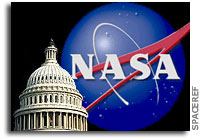NASA Authorization Act Markup (Update)

House Science Committee Markup of NASA Authorization Act for 2016 and 2017
– H.R. 2039, the National Aeronautics and Space Administration Authorization Act for 2016 and 2017
– H.R. 2039 Highlights
NASA Administrator Statement on House Authorization Bill
“The NASA authorization bill making its way through the House of Representatives guts our Earth science program and threatens to set back generations worth of progress in better understanding our changing climate, and our ability to prepare for and respond to earthquakes, droughts, and storm events. In addition, the bill underfunds the critical space technologies that the nation will need to lead in space, including on our journey to Mars.”
House Science Committee Passes NASA Reauthorization by Party-line Vote
“Ranking Member Eddie Bernice Johnson (D-TX) said in her opening statement, “These cuts have absolutely nothing to do with making America safer or stronger. Nothing. They are simply the expression of the Majority’s stick-your-head-in-the-sand ideology. This is especially disappointing because we had worked so hard just three months ago to make our NASA authorization a bipartisan bill which could be broadly supported by the aerospace and science community. It’s a shame to be throwing all that work away in pursuit of a narrow ideological agenda.”
– Letter from the American Association for the Advancement of Science
– Letter from the American Astronomical Society
– Letter from the Association of American Universities
– Letter from the American Geophysical Union
– Letter from the American Institute of Aeronautics and Astronautics
– Letter from the Geological Society of America
– Letter from the Universities Space Research Association
OSTP Director Holdren: House-Proposed Funding Cuts to NASA Earth Science and Space Technology Programs
“If enacted, the NASA authorization bill headed to the House floor later this month would do serious damage to the Nation’s space program, as well as to Earth-observation and Earth-science programs essential for predicting, preparing for, and minimizing the damage from disasters both natural and human-induced. The bill’s cuts to space-technology development would not only risk continued U.S leadership in the space industry, but would also impede progress on precisely those technologies – on-orbit refueling, advanced space propulsion, radiation protection in deep space, and more – needed to make crewed missions to deep space a reality.”









…and frankly, we’ve been spending way too much on “climate change” over the last ten years given that the observed temps do not match the models, not by a long shot. Spend more on actual space tech development and less on climate “studies”.
The temps don’t match the predictions exactly, but they fall within the confidence interval of the predictions, as would be expected of robust models/theories.
?
That makes not the slightest, most microscopic sense. The models are the RESULT of data gathering and subsequent analysis. If we assume your position is correct (for arguments sake), then we need to spend far MORE on environmental studies and upgrade our models to be more precise and predictive.
Its like saying that weather forcasts are not very reliable so lets stop spending money gathering weather data and tuning our prediction programs.
I always think letting politicians micromanaging scientific research is more than absurd. If congress should simply allocate $5B to space science and let NASA to decide how to spend that money, how much do you think earth science would get? I think they would likely get less than what republicans have given them in this bill.
That makes no sense. You say “NASA” should decide. Who is “NASA”? The decision-making NASA leadership is selected by the President and the nominees approved by congress. The Agency leaders are generally in sync with the President.
Quoth the current NASA admin:
“The NASA authorization bill making its way through the House of Representatives guts our Earth science program and threatens to set back generations worth of progress in better understanding our changing climate, and our ability to prepare for and respond to earthquakes, droughts, and storm events.
NASA leads the world in the exploration of and study of planets, and none is more important than the one on which we live.”
So, based upon your suggestion, Earth Science gets MORE, not LESS.
The puppet master lit a match and spoke.
The puppets danced as the theater smouldered around the unwary and hopelessly trapped children.
Hmm, congress has the idea that if you ignore it, it will cease to exist. I wish that idea worked with congress.
Hey, we got the best Congress that money can buy!
Hence his call not to slash even the current underfunding and make things worse.
Unless something like a “Sputnik” event occurs, like a Chinese Moon landing, NASA will be always bogged somewhere in the current funding range +/-.
That is why New Space is so appealing, it is not stuck in the tidal muck.
I know I will be distinctly in the minority here but I am quite excited and satisfied with this budget. Commercial Crew, Planetary Science, and SLS/Orion get full funding. Commercial Crew gets an increase of at least $330 Million (more in the “aspirational” scenario), SLS and Orion don’t experience over $400 Million in cuts (which would really hurt the program and its long term affordability), and Planetary Science gets enough to keep running LRO and Opportunity.
Only Earth Science receives a substantial haircut. Given how much of an increase they got these last 6 years they are best placed to endure the cuts. They are still getting around the same amount as Planetary Science.
It makes me laugh when I see Holdren trying to pretend he cares about human spaceflight. Space Tech gets over half a billion in the budget and without a heavy lift vehicle like SLS we won’t be able to launch large enough fuel depots and SEP stages for deep space missions. All Holdren cares about is climate change science.
“I know I will be distinctly in the minority here”
Not necessarily. There just may be a quite vocal minority (and vocal I am!). Your voice may be mainstream for the huge lurker class.
Altho because this is a NASA gadfly blog, it may attract mostly the people of generally opposing view. Who knows?
I do have a quibble with comment on the “increase” in earth Science. It really was a reinstatement to almost, but not quite, the funding levels (inflation adjusted) from previous to the last administration.
Holdren is a smart guy, but I have been annoyed with him for many decades because he often refuses to be absolutely direct and conclusive and prefers to take softer stands. I think that trying to be political sometimes leaves one ineffective.
“All Holdren cares about is climate change science.” I assume you are talking in reference to NASA funding. His interests are much broader generally. He has a lifetime of activity in nuclear arms control, environmentalism, etc.
Honestly I would have preferred more money for Earth Science and you are correct in saying that it was higher during the Clinton Administration.
That said if I remember correctly the entire NASA budget was higher than it is today under Bush II and Clinton administrations. Something had to give and given that Earth Science had the benefit of “increases” throughout the Obama era they are the best placed to take the hit.
Also Earth Science has the “easiest” job in SMD relatively speaking. They don’t need to launch their missions and wait 7 years for their craft to reach the target like planetary scientists do.
Finally, I would add that even under this bill Earth science gets as much as science for the other 7 planets combined. This bill is definitely not the end of Earth Science.
P.S. Yes, I was referring to Holdren’s views on the NASA budget, not his overall activity.
It is wrong to gut Earth Science for Planetary Science. BOTH are valid. Other places should be the source of money.
Earth Science funding is still way below minimum. It has a much bigger operational responsibility with vastly more moving parts. Plus it is the part of the budget that is most directly and immediately tied to the health, safety, and general welfare of the public. The Heliophysics Science Division also has important responsibilty for space weather and Planetary Science has NEO work underfunded at a few $10s of millions, but it is very minor.
The Earth Science division has responsibilities covering everything from volcanoes to Nasa/Noaa to tsunamis, not just climate change.
They process many terabytes of data a day. They have aircraft, field offices, expeditions, satellite systems, global network land, sea, and air sensors, vast data processing, analysis, and modeling etc.
Using spacecraft as a scale for comparison,
Planetary Science current operating missions:
Cassini, Dawn,Juno, LRO, Opportunity, Mars Odyssey, MRO, Curiosity, MAVEN, New Horizons
Earth Science operates:
AirMOSS, Aqua, Aquarius, ATTREX, Aura, CALIPSO, CARVE, CloudSat, DISCOVER-AQ, NMP EO-1, GOES I-M, GOES N-P, GPM, GRACE, HS3, LAGEOS 1, LAGEOS 2, Landsat 7, Landsat 8, NOAA-N, OCO-2, IceBridge, OSTM, QuikSCAT, RADARSAT-1, ADEOS I, SMAP, SORCE, Suomi NPP,
Terra, TRMM,
Comparable ratios apply to hardware being readied for launch and hardware being planned.
Planetary Sciece Division does work important beyond measure expanding our understanding and laying the groundwork for our expansion into space and deserves multiple of its current funding.
But not at the expense of the irreplaceable and indispensable and underfunded Earth Sciences Division
Nice research.
I stare at computer screens all day, and then at home I stare at computer screens. On the train home, I stare at a smartphone screen or ipad screen.
My universe is a 2 dimensional plane about 3 feet from my eyeballs..
Scumballs Cruz, Rubio, et al, are playing the same game that the British did all over their empire, inflame rivalries and divide and conquer. Hindu vs Muslim in India, Jew vs Arab in Palestine, etc.
The agencies being victimized are pushed to fight each other for the scraps, rather than taking on the SOURCE of their problems.
The relevant criterion isn’t payload, it’s payload per dollar. How does SLS compare on that parameter? SEP is very scalable and quite powerful payloads can be launched on existing ELVs. We need to develop the technology.
Without massive fuel depots launching a manned mission beyond Earth with existing ELVs doesn’t work. Payload per dollar is second to “can I actually get the payload where I need it to go.” Then of course there are the multiple launches and on-orbit assembly required when ELV’s are used vs. fewer launches with more payload for a HLV. Given the experience with ISS I think the better option would be the latter.
I’m no rocket engineer but since both SpaceX and NASA (the experts) are trying to build a HLV (with payload capacity tripling or quadrupling current LVs) I think I will go with their expertise and say we need a HLV.
ULA has almost all of the technology to build and fly fuel depots. They’ve been flying Centaur for how long? They have the cryogenics experience to make this work. Worst case, you switch from liquid methane for the fuel, which isn’t as deeply cryogenic as LH2.
With the money spent so far on SLS, who here doubts that fuel depots could have been developed and flown by now?
I think it depends on the fuel and the HLV. BTW – the sooner HLVs and SHLVs become available, the happier I will be.
If you use liquid methane, which is roughly the same temp as LOX – (vastly simplifying tanking and pumps, etc), you get a super advantage: passive radiator cooling is effective and allows very long-term storage.
What can be done with what we have in current or near term vehicles?
The sls block 1 is 70tons to LEO.
The FH is 53tons and is designed for reusability of lower stages (and vastly, astronomically, galactically lower costs even as an expendable).With the enhanced Merlins (debuting in July), super-dense LOX and cross-feed propellent, this performance should be exceeded.
The FH would make a valid tanker.
The planned BFR, which should be coming online during the time period of interest, is fully HLV/SHLV and designed to be fully reusable, and methane fuelled.
Since American Astronomical Society is so understanding and compassionate, they should volunteer cutting of NASA astronomy funding by 80% so congress can fully fund earth science as the president asked.
Obama – $1.10 billion
Romney – $1.13 billion
All leaders are horrible. However some are more horrible than others and also some will push (however ineffectively) for things that match you wants. So you have to hold your nose and vote for the ones closest, even by an millimeter to your preferences.
My favorites for prez have always been impossibilities. Back in the 70’s I ran as a delegate for Jerry Brown. I’ve always liked Bernie Sanders. Ed Markey. Liz Warren. Martin O’Malley.
Agreeing with you so often is getting tiresome 🙂
I also like Joe Biden. Go figure.
I think green beans are the most horrible tasting creation of natural and artificial selection.
What is your view on the issue?
Mr.Obama pressed for increased investment in Earth observation, including climate change, which is critical to our survival in the immediate future. If we lose the Earth, most of us are going to die. Mr. Obama also pressed for investment in space technology, which we need to make space accessible. You may disagree.
I have nothing against occasional hyperbole. But if you really think that Mr.Obama believes the solar system will cease to exist if he ignores it, you might wish to present some supporting evidence.
Thanks, the paper by Adams, Maslin and Thomas was interesting. Here’s a quote from it. Do you agree with the authors?
“Sudden stepwise instability is also a disturbing scenario to be borne in mind when
considering the effects that humans might have on the climate system through adding
greenhouse gases. Judging by what we see from the past, conditions might gradually
be building up to a ‘break point’ at which a dramatic change in the climate system will
occur over just a decade or two, as a result of a seemingly innocuous trigger.” ethomas.web.wesleyan.edu/ad…
“. ..predicting what will happen with imperfect incomplete models..”
I agree. But we need to be able to predict, so that we are not caught flat-footed. That means we need better models. The computer science side is doing its part with vastly better simulation hardware. The critical need is for the data to construct more accurate models.